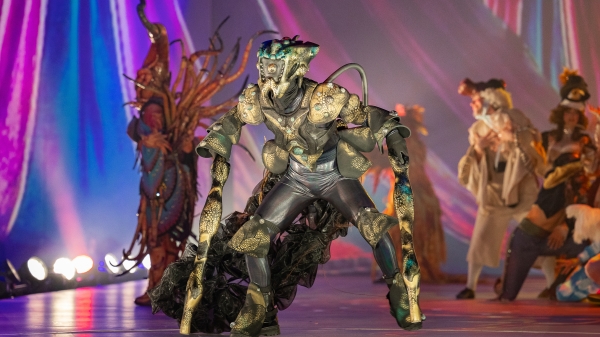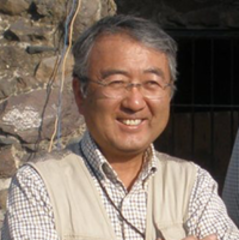Spider monkey remains uncovered in central Mexico tell important story of trade, politics

*Animal, not human, remains* (A) Plan view map of Offering D4. Pink: animal remains; green: shell; purple: obsidian; yellow: other. Drawing by N.S. (B) Photograph of eagle (left) and spider monkey (right). (C) Scan of mural fragment of a spider monkey. Images courtesy Project Plaza of the Columns Complex
The bones and teeth of a spider monkey found in a ceremonial grave at Teotihuacan, an ancient city in central Mexico that was once one of the largest cities in the world, reveal new information about the relationship between Teotihuacan and Maya civilizations.
The team of archaeologists who made the discovery at Teotihuacan (circa 250 to 300 A.D.) are with the Plaza of the Columns Complex (PCC). The discovery is believed to be the first example of primate captivity and trading. It also sheds light on important political relations between the Teotihuacan and Maya.
The ancient site of Teotihuacan is located in central Mexico, while Maya cities are found in the southern region about 1,000 kilometers away.
The article, “Earliest evidence of primate captivity and translocation supports gift diplomacy between Teotihuacan and the Maya,” was published in Proceedings of the National Academy of Sciences. Archaeologist Saburo Sugiyama is a research professor with Arizona State University's School of Human Evolution and Social Change and was involved in the PCC project. He was also co-author of the paper.
Sugiyama said scientists found evidence of material from Teotihuacan in several Maya centers. But they did not see a strong Maya influence at Teotihuacan until these recent discoveries.
The scientists said there have been two previous times when a tooth from a howler monkey and part of a spider monkey's left arm were found in Teotihuacan from the Maya. However, this full spider monkey skeleton is a first.
“The discovery of the spider monkey, and the analyses of materials associated with the monkey, tell us that the Maya also brought special objects from the Maya tropical lowland to the Mexican highlands, including this living spider monkey,” Sugiyama said. “The relationship between two very distant areas was not only a political interaction but also a social event that probably impacted multilayered citizens living in Teotihuacan.”
The scientists explain that the spider monkey’s remains date 100 years earlier than the historical “Entrada” event, detailed in the paper as a time when Teotihuacan brought a military presence to Maya sites.
“The Entrada was named for a possible incident that happened in January of 378 A.D. in the Peten area around Tikal, one of the largest Maya centers in Guatemala, according to the histories recorded by the Maya writing system,” Sugiyama said. “The ‘people from the west’ were presumably from Teotihuacan because archaeological records can't suggest any other city came with the military corp and probably conquered Tikal and surrounding regional Maya centers.”
Saburo Sugiyama
This discovery indicates political relationships happened between the two cultures earlier than previously thought. Scientists were able to determine the spider monkey was female, was about 2 years old when it was captured and was moved from a tropical climate to a dry one by analyzing bones, teeth, soil and ceramics found in the ceremonial mound.
The monkey was buried alive, with its hands and feet bound, along with a golden eagle, puma skull, various rattlesnakes, small birds, shells and obsidian goods. Sugiyama explains being buried alive was done “probably to empower the sacred monument.”
“We concluded the tunnel excavation at the Mound 25C and the Offering D4 during the summer of 2022. We will continue expanding the excavation the next summer, in 2023, with National Science Foundation funding and the Japan Foundation for the Promotion of Science of the Japanese government, as an international joint project with the Mexican Institute of Anthropology and History; Okayama University, Japan; and the University of California, Riverside,” Sugiyama said.
More Arts, humanities and education

ASU student finds connection to his family's history in dance archives
First-year graduate student Garrett Keeto was visiting the Cross-Cultural Dance Resources Collections at Arizona State University…

ASU alumna makes her way back to the ASU Gammage stage for '¡azúcar!'
As the Los Angeles-based CONTRA-TIEMPO dance group prepares for its upcoming production “¡azúcar!” at ASU Gammage, for one member…

ASU FIDM professor wins international award for fantastical, sustainable creation
The horror of an ailing Earth inspired an Arizona State University fashion professor to create a fantastical garment out of…
